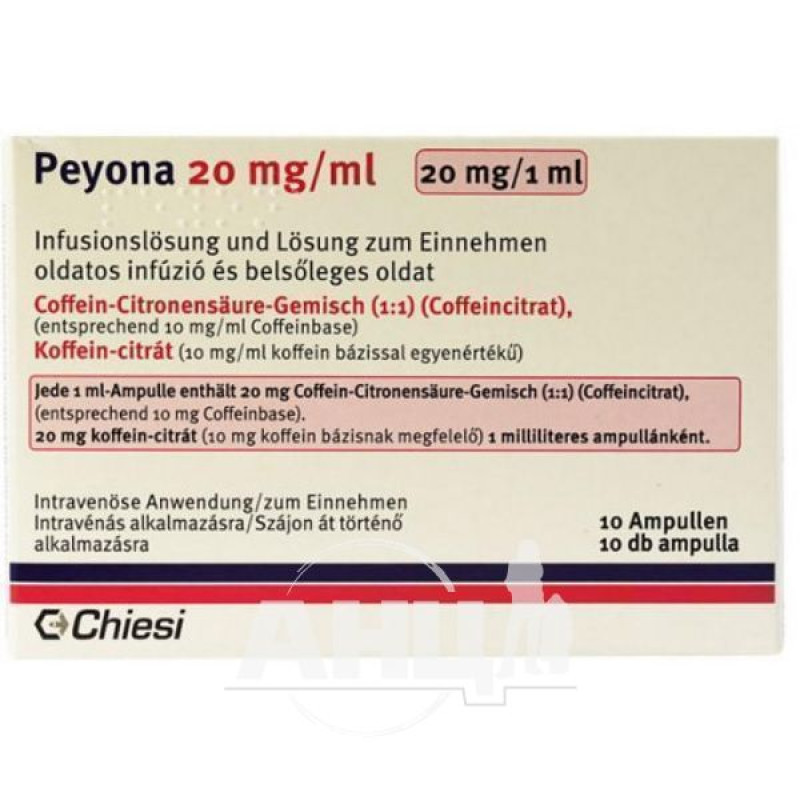Peyona solution for infusions and oral administration 20 mg/ml ampoule 1 ml No. 10

Solution for infusion and oral administration "Peon" is used in the treatment of primary apnea in premature newborns.
Composition
The active substance is caffeine citrate (1 ml of the medicinal product contains 20 mg of caffeine citrate (equivalent to 10 mg of caffeine)).
Excipients: citric acid monohydrate; sodium citrate; water for injections.
Contraindication
Hypersensitivity to the active substance or to any of the excipients.
Method of application
Caffeine citrate therapy should be initiated under the supervision of a physician experienced in neonatal resuscitation. The drug should only be administered in a neonatal intensive care unit with appropriate equipment for observation and monitoring.
Dosage
The recommended dose for infants receiving therapy for the first time is 20 mg caffeine citrate per kg of body weight by slow infusion over 30 minutes using a syringe pump or other adjustable infusion device. After 24 hours, maintenance doses of 5 mg per kg of body weight by slow infusion over 10 minutes every 24 hours are permitted. Alternatively, oral maintenance doses of 5 mg per kg of body weight every 24 hours are permitted using devices such as a nasogastric tube.
The recommended loading and maintenance doses of caffeine citrate are listed below with an explanation of the relationship between the volume of drug administered and the volume of caffeine citrate administered.
The dose expressed as a dose of caffeine is half the dose expressed as caffeine citrate (20 mg of caffeine citrate is equivalent to 10 mg of caffeine).
Shock dose:
caffeine citrate dose (volume) - 1.0 ml/kg body weight; caffeine citrate dose (mg/kg body weight) - 20 mg/kg body weight; method of administration - intravenous infusion (over 30 minutes); frequency - 1 time.Maintenance dose (starting 24 hours after the loading dose):
caffeine citrate dose (volume) - 0.25 ml/kg body weight; caffeine citrate dose (mg/kg body weight) - 5 mg/kg body weight; method of administration - intravenous infusion (over 10 minutes) or oral administration; frequency - every 24 hours (starting 24 hours after the loading dose).In the absence of an adequate therapeutic effect in premature newborns after the administration of the recommended loading dose, a repeated loading dose of 10-20 mg/kg is allowed after 24 hours.
If there is no adequate therapeutic effect, an increase in the maintenance dose to 10 mg/kg may be considered, taking into account the potential for caffeine accumulation due to its long half-life in premature infants and the progressive increase in the ability to metabolize caffeine with increasing gestational age. Plasma caffeine levels should be monitored if clinically indicated. If there is no adequate therapeutic effect after a repeated loading or maintenance dose of 10 mg/kg/day, the diagnosis of apnea of the newborn may need to be reconsidered.
Application features
Pregnant women
In animal studies, caffeine has been shown to be embryotoxic and teratogenic at high doses. These effects are not associated with short-term administration in a group of premature infants.
Caffeine is excreted in breast milk and rapidly crosses the placenta into the fetal bloodstream. Mothers who are nursing infants treated with caffeine citrate should avoid foods, beverages, and medications containing caffeine. In infants whose mothers consumed large amounts of caffeine before delivery, baseline plasma caffeine concentrations should be determined before initiating caffeine citrate treatment.
The effects on the reproductive system observed in animals were absent in premature neonates.
Drivers
There is no ability to influence the reaction speed when driving vehicles or other mechanisms.
Overdose
According to published data, after an overdose, the level of caffeine in plasma ranged from 50 mg/l to 350 mg/l.
Symptoms
In the literature, reports of symptoms of caffeine overdose in premature infants include hypoglycemia, hypokalemia, fine tremor of the extremities, agitation, hypertension, opisthotonus, tonic-clonic convulsions, epileptic seizures, tachypnea, tachycardia, vomiting, gastric irritation, gastrointestinal bleeding, fever, hyperexcitability syndrome, increased blood urea and leukocytosis, and uncontrolled jaw and lip movements. One case of caffeine overdose was reported to be complicated by intraventricular hemorrhage and long-term neurological complications. There are no reports of deaths resulting from caffeine overdose in premature infants.
Actions in case of overdose
In case of caffeine overdose, symptomatic and supportive treatment is mainly provided. Potassium and glucose levels should be monitored and measures taken to correct hypokalemia and hyperglycemia. Studies have shown that plasma caffeine levels decrease after blood exchange transfusion.
The pharmacology and toxicology of caffeine and other methylxanthines provide information on possible adverse reactions to caffeine citrate. The effects described include central nervous system stimulation such as irritability, agitation, and hyperexcitability, and cardiovascular effects such as tachycardia, hypertension, and increased cardiac output. These effects are dose-dependent and may require plasma concentration monitoring and dose reduction.
Common (≥ 1/100 to < 1/10) adverse reactions that may be associated with caffeine citrate and have been reported in the medical literature are listed below.
General disorders and administration site conditions: infusion site phlebitis, infusion site inflammation.
Storage conditions
Store in the original packaging at a temperature not exceeding 25 °C, out of the reach of children.
Shelf life - 3 years.
After opening the ampoule, use the medicine immediately.
There are no reviews for this product.
There are no reviews for this product, be the first to leave your review.
No questions about this product, be the first and ask your question.

